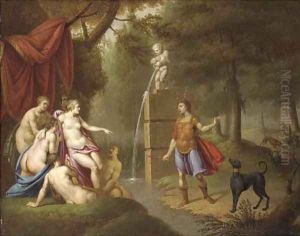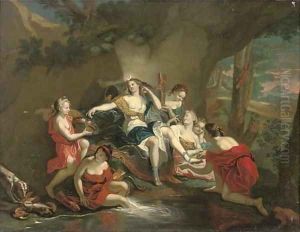Sebastien Leclerc, Called Leclerc Des Gobelins Paintings
Sébastien Leclerc, also known as Sébastien Leclerc des Gobelins, was a prolific French artist, engraver, and draftsman born on September 26, 1637, in Metz, France. His work spanned several disciplines, including painting, engraving, and architecture, making him a versatile figure in the art world of the 17th and early 18th centuries. Leclerc is particularly known for his detailed engravings that captured both the scientific spirit and the artistic elegance of his era. He was also recognized for his contributions to the decorative and architectural designs of his time, particularly in relation to the Gobelins Manufactory, from which his epithet 'des Gobelins' is derived.
Leclerc showed an early talent for drawing and was initially trained by his father, Sébastien Leclerc I, a painter and engraver. Seeking to broaden his horizons, he moved to Paris, where he studied under the painter and engineer Charles Errard. In Paris, Leclerc's skills flourished, and he became known for his engravings, which combined technical precision with a keen eye for detail. His works include illustrations for books, scientific diagrams, and architectural plans, reflecting a wide range of interests and expertise.
In 1672, Leclerc was admitted to the French Royal Academy of Painting and Sculpture, a significant recognition of his talents and contributions to the arts. His association with the Gobelins Manufactory, a royal enterprise known for producing tapestries, furnishings, and various objects of art for the French royal palaces, marked a significant phase in his career. Leclerc's designs and engravings played a crucial role in the development of the Gobelins' aesthetic and contributed to the prestige of French artistic production during the reign of Louis XIV.
Leclerc's work was not limited to engravings and design; he also wrote and illustrated treatises on geometry, perspective, and military architecture, showcasing his intellectual interests and his desire to merge artistic practice with scientific inquiry. His influence extended beyond France, with his works being collected and studied across Europe.
Sébastien Leclerc died on October 25, 1714, in Paris, leaving behind a rich legacy of artistic and intellectual contributions. His engravings continue to be studied and admired for their beauty and precision, and his impact on the visual culture of the Baroque period remains significant. Leclerc's work exemplifies the blend of art and science that characterized the Enlightenment and continues to influence the fields of art and architectural history.

